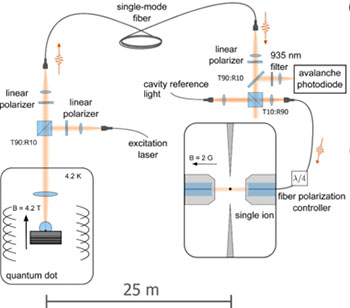
The experimental setup used optical fiber to link a quantum dot system with a trapped-ion system, via photons generated by the quantum dot. [Image: Meyer et al., Phys. Rev. Lett., doi: 10.1103/PhysRevLett.114.123001]
In recent years, researchers have made great strides in understanding and manipulating individual quantum systems, such as quantum dots or trapped ions. But control of hybrid systems consisting of both elements—a potential boon to quantum computers and memory systems—has remained elusive. An international team of scientists now reports the first direct photonic link between a semiconductor quantum dot (QD) and a trapped ion, two very different, complementary systems, with single photons from the QD used to change the quantum state of the ion (Phys. Rev. Lett., doi: 10.1103/PhysRevLett.114.123001).
Hybrid systems have held attraction for researchers in quantum computing, because they offer the potential to use the strengths of each physical system in combination. Quantum dots, as “artificial atoms,” can be relatively easily manipulated electro-optically to create a specific electron quantum state, and pump out quantum information in the form of single photons, but the electron quantum states in QDs have relatively low coherence times. Natural atoms, such as ions, are harder to manipulate, but their electron coherence times are much longer, making them ideal candidates for storage of quantum information. Putting these complementary systems together has obvious benefits for practical quantum computing—but how to accomplish the link?
To tackle that problem, two scientists from the University of Cambridge, U.K.—Mete Atatüre, an authority on quantum dots, and Michael Köhl, an expert on trapped ions (also affiliated with the University of Bonn, Germany)—joined forces with colleagues from other institutions in Germany, the U.K. and France. Their hybrid system used 50 m of single-mode optical fiber to tie an indium arsenide quantum dot, within a gallium arsenide host in a magneto-optical cryostat operating at 4.2 K, with a single 174Yb+ ion trapped in an optical cavity designed to be resonant with the ion’s 935-nm transition frequency.
The team fired laser pulses at the QD to send a stream of single 935-nm photons down the optical fiber, and read out their excitation of the electrons in the ion—thereby establishing a single-photon-to-single-ion connection between the two quantum systems. They also showed, in a separate experiment, that quantum information (specifically the spin state of the electron excited in the QD by the laser) was transferred, via the photon, from the QD to the internal quantum state of the ion, where it potentially could be stored for many minutes.
One big hurdle still to be surmounted is the efficiency of the process: in these experiments, only five photons in a million generated by the quantum dot actually excited the Yb ion. The researchers believe that improvements in QD photon collection efficiency and other technical developments will help to surmount these problems, and make these kinds of hybrid systems an increasingly attractive platform for quantum information applications.
